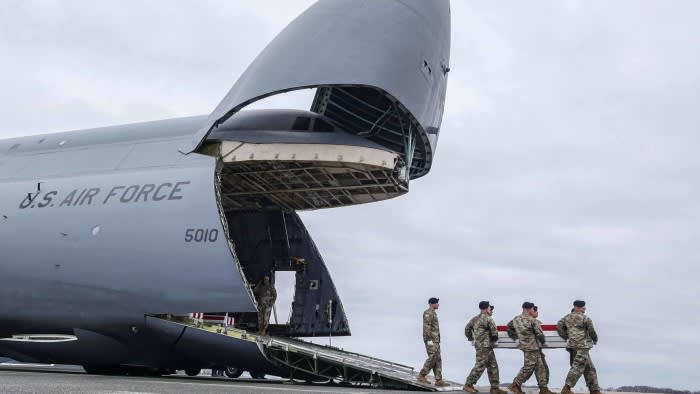Unlock the Editor’s Digest for free
Roula Khalaf, Editor of the FT, selects her favourite stories in this weekly newsletter.
Iran and Iraq have warned that a wave of US strikes against militants backed by Tehran could trigger greater instability across the region.
The US military said it hit 85 targets at seven facilities in Iraq and Syria on Friday that were associated with Iran’s elite Revolutionary Guards and Iranian-backed militias.
It was the first of what President Joe Biden said would be a series of retaliatory strikes for the drone attack on a base on the Jordan-Syrian border that killed three US servicemen last month.
The Iraqi government said on Saturday that 16 people, including civilians, were killed in the US attacks, warning that they would “put security in Iraq and the region on the brink of the abyss”.
Iran’s foreign ministry condemned the strikes as a violation of international law and said the US was engaging in “another adventurous and strategic error”.
The Syrian military said that “many civilian and military martyrs” were killed, but did not provide further details.
The US attacks underscore the delicate balance Biden is trying to manage. Washington is under pressure to respond to Iranian-aligned militant attacks against American forces while also trying to avoid being drawn deeper into a widening regional conflict.
The air strikes, which hit four sites in Iraq and three in Syria, marked the first time the US has targeted Iran’s powerful Qods Force since the outbreak of the war between Israel and Hamas in October triggered hostilities across the Middle East.
The Qods Force is the wing of Iran’s Revolutionary Guards that is responsible for overseas operations and trains and arms militants in the region.
Biden has said repeatedly that he wanted to avoid a wider war, but he signalled on Friday that Washington would continue to hit back if Iranian-aligned militants attacked American targets.
“The United States does not seek conflict in the Middle East or anywhere else in the world,” Biden said. “But let all those who might seek to do us harm know this: If you harm an American, we will respond.”
Since the Israel-Hamas war erupted, Iran-backed militias have launched more than 160 drone and rocket attacks against US forces in Iraq and Syria. But the attack on the base on the Jordanian-Syrian border last Sunday was the first in which US troops were killed.
The US has previously targeted militants in Iraq and Syria, but Friday’s strikes were by far the biggest of the past three months, amid concerns that the Middle East was sliding dangerously towards a broader conflagration.
There are about 2,500 US troops in Iraq and some 900 in Syria where they are deployed to prevent the resurgence of Isis, the jihadist group.
The US has also been drawn into combat with Iranian-backed Houthis who have launched attacks against Israel and commercial shipping in the Red Sea and Gulf of Aden.
The US and UK have carried out multiple attacks against the Houthi’s military facilities in Yemen.
Iranian officials have said the Islamic republic does not want direct conflict with the US and Israel, or a regional war. Tehran insists that the militant groups it backs have been acting independently in their opposition to Israel’s offensive in Gaza and support for the Palestinians.
“We are not seeking war, but we are not afraid of it,” Major General Hossein Salami, commander of the guards, said this week.
Washington blamed last Sunday’s drone attack on its base on the Jordan-Syria border, which also wounded 41 US service members, on the Islamic Resistance in Iraq.
It is a shadowy umbrella group that is believed to include fighters from Kataib Hizbollah, an Iraqi Shia militia, as well as other militants that have claimed responsibility for the attacks against US troops in Iraq and Syria.
The IRI is part of Iran’s so-called Axis of Resistance, which includes militant groups such as Hizbollah in Lebanon and the Houthi rebels, which control northern Yemen.
The US employed long-range B1 bombers in the Friday’s strikes in Iraq and Syria, as well as other aircraft, senior US officials said.
More than 125 precision munitions were fired and hit facilities including command and control and intelligence centres; rocket, missile and drone storage sites; and logistic hubs, Centcom said.
“We made these strikes tonight with an idea that there would likely be casualties associated with people inside those facilities,” said Lieutenant General Douglas Sims, director for operations for the US Joint Chiefs of Staff.
